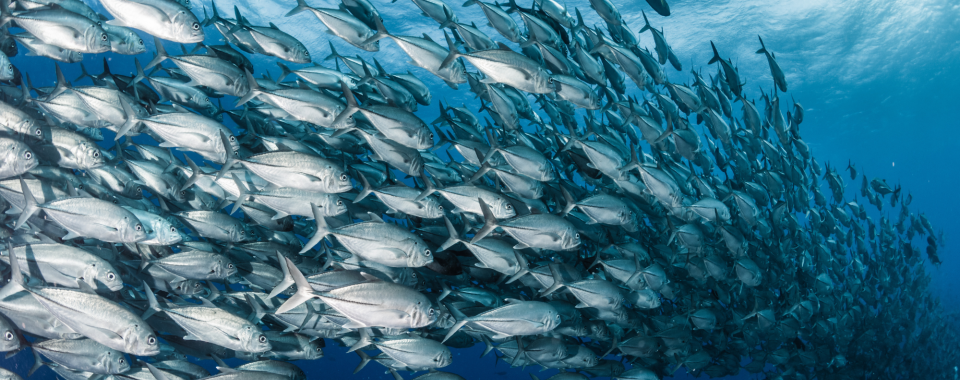
Photo by Adobe Stock
By Alaina O’Regan
July 21, 2025
For 50 years, scientists believed that schools of fish swim in flat diamond formations to save energy. Recently, a team of researchers at Princeton and Harvard ran experiments to put this to the test.
They discovered that fish actually tend to swim in a dynamic pattern that the researchers call a ladder, where they’re staggered in three dimensions like an echelon of fighter jets. The findings can help engineers design more efficient underwater robots for tasks like monitoring reefs and kelp forests. The paper was published June 27 in Scientific Reports.
“Fish have a whole hidden world of how they cooperate together that we don't still understand,” said Radhika Nagpal, the Norman R. Augustine '57 *59 Professor in Engineering and the study’s principal investigator. “They are so good at what they do in an environment that we don't even know how to move in well.”
The researchers developed novel machine learning software to create the first accurate 3D representation of a fish school’s movements over time. Working with Harvard University biologist George Lauder, they analyzed a group of six giant danios swimming for 10 hours in a tank with recirculating flow.
They found that the fish almost never formed a diamond, and instead swam in a ladder shape 79 percent of the time. “It opens a whole new can of mysteries,” said Nagpal. “Everything that was thought to be true is actually not what’s going on.”
Until now, studies of fish schools have generally been limited to shallow water, where fish can only swim in flat, 2D formations. This is because tracking fish in three dimensions presents major technical challenges, according to Nagpal.
When one fish swims behind another, for example, it disappears from view, and the software has to guess the fish’s position based on limited visual data. Stitching together multiple camera angles can help, but requires complex algorithms to identify and track each fish.
The Princeton team overcame this barrier by adapting a computer vision software that tracks individual animal movements, originally developed by Princeton researchers, to capture and model a school of fish.
“It’s pretty surprising,” said Hungtang Ko, postdoctoral researcher and lead author on the study. “We knew that fish can form 3D formations, but we didn't exactly expect any certain formation to emerge as the most popular.”
The researchers said this work has interesting applications in robotics. The Nagpal lab is working on fish-inspired underwater robot swarms that in the future could move in similar dynamic ladder formations and gain energetic benefits.

Nagpal said an important next step is to understand why fish choose to organize in the ladder shape. “We can hypothesize why it might be a good choice, but it's still unclear,” she said.
One reason could be that staggering both top-to-bottom and side-to-side allows more flexibility for the fish to avoid being directly behind one another. “When swimming, fish on average generate a jet going backward, like the jet engine of a plane,” said Ko. The ladder formation likely provides similar hydrodynamic benefits as in the diamond shape, but the fish may not have to work as hard to synchronize, he said.
The researchers said the project is not just about improving engineering applications, but also improving understanding of fish behavior – like how they move in coral reefs and what perturbations affect them – for ocean conservation efforts. “Working with biologists and environmentalists to learn about fish schools will allow us to interact better with the underwater world,” Nagpal said.
“The collaboration is a two-way street,” said Ko. “We can use computer vision to discover how and why animal groups do things together. And then we can ask, what kind of real-world robotic system could this biological insight be applied to?”
This paper, “Beyond planar: fish schools adopt ladder formations in 3D,” was published June 27 in Scientific Reports. In addition to Nagpal, Ko and Lauder, the authors include Abigail Girma, Yangfan Zhang and Yu Pan. The research was supported by ONR MURI grant N00014-22-1-2616. Ko is supported by the James S. McDonnell Foundation’s Postdoctoral Fellowship for Understanding Dynamic & Multi-scale Systems and the Company of Biologists Travelling Fellowship. Zhang is supported by a Postdoctoral Fellowship of the Natural Sciences and Engineering Research Council of Canada and a Banting Postdoctoral Fellowship of NSERC & Canadian Institutes of Health Research.